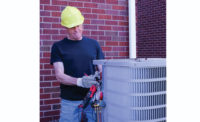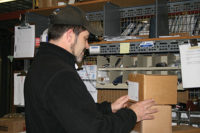A decade of Uber has changed the transportation-for-hire business permanently. Although the service provided through Uber is much the same as a taxi, the startup company has decimated its traditional yellow competitor and opened the market for new competition like Lyft, which began in 2012. No longer subject to hailing a cab on a rainy corner and watching the rate meter tick higher with each minute, Uber and Lyft customers can see the cost, order a ride, and pay for the trip all on their mobile device. The primary difference? Experience.
The experience that customers have with HVACR companies can be a game changer, too, especially when it comes to pricing. Effective pricing procedures are diverse in their applications, but these four concepts can help stop customers from asking, “Why does it cost so much?”
STOP SELLING WHOLESALE
Access to the internet and a bevy of low-priced manufactured goods has many HVACR customers questioning why a service contractor is charging such a high rate to change a filter when the commodity itself can be rather inexpensive. Danielle Putnam, president of The New Flat Rate, Dalton, Georgia, said it is critical that contractors remember the difference between wholesale and retail when it comes to pricing.
“Customers will say, ‘I can see it on Amazon right now. Why are you charging me $150 for a tune-up when the filter only costs around $27?’” said Putnam. “You have to remind them that the price they see is wholesale and that when they walk into a store to purchase items, what they are buying is retail, not wholesale.”
She explained that contractors have to bring the retail mentality to the home and remind customers that they are buying not just a wholesale part but a service and a guarantee.
“The customer didn’t just need a new filter, they needed a service provider that’s licensed and insured to show up at the door, greet them, and take care of their concerns,” said Putnam. “That’s retail. It’s changing the customer perception and adjusting their perceived value. So when contractors price things, they need to remember that it is not about commodity and the wholesale of the parts, but it is about the whole value of retail buying.”
TRUST THE RIGHT PERSON
When the topic of legitimate pricing is on the table, customer trust goes a long way. There are several approaches to earning this trust, and each company is responsible for creating a set of strategies that works for their situation. For Rosenberg Indoor Comfort in San Antonio, Texas, the company relies on show-and-tell to help explain its pricing to the customers.
“We show the client exactly what needs to be done,” said Michael Rosenberg, president of the company. “If the unit is in the attic or outside and the client does not want to go there, we take pictures of the repairs needed and show them to the client, while we build value in the recommendations.”
Not only does Rosenberg Indoor Comfort use these photos, but the company starts building trust from the moment one of its trucks pulls into the driveway.
“We drive up in a clean, marked truck with a professionally trained service technician and go from there,” explained Rosenberg. “We also work hard to establish our reputation and trustworthiness by obtaining reviews on websites such as Google, Angie’s List, Yelp, and Nextdoor; as well as by rewarding customers for referrals to family and friends.”
As general manager of Wojo’s Heating, Air Conditioning & Plumbing, based in Northwood, Ohio, Chuck Westenbarger believes that gaining trust starts with the credibility of the technician and the company. He encourages the company’s technicians to not only give repair prices before doing the work, but also to communicate warranties and the pricing structure to clients.
“Our technicians spend time with the client, building that credibility while building a relationship with the client,” said Westenbarger. “If a client doesn’t think the technician is competent, then they won’t trust the diagnosis or the pricing. In our business, the technician is the ‘face’ of the company, so he or she having credibility helps to establish trust.”
Although technicians are generally the trust-builders on service calls, Putnam cautioned contractors to ensure that technician trust is a temporary conduit to long-term company trust.
“Yes, you want technicians in the home to be trusted, but trust between your customers and your company is going to be what builds a long-term, reliable customer base,” she said. “If we give the relationship to our tech, then they can quit and go become our competitor and bring along all of their loyal customers that weren’t theirs to begin with.”
To help combat this issue, Putnam advised that contractors maintain a good, solid company reputation directly with their customers and their communities. She also said that service managers or owners should visit the company’s jobsites and shake hands with the customer to ensure that the relationship stays with the company.
TECHS AREN’T SALESMEN
Despite their talents as HVAC technicians, a majority of the men and women making service calls in HVAC would likely not qualify for the sales positions posted on contractors’ websites. Putnam clarified this notion, explaining that technicians are service providers and craftsmen, not salesmen.
“Whether contractors use a sales pricing tool — be it software, a price book, or flyers and brochures — it is the company’s responsibility to lay that out and to make sure that it’s communicated correctly,” said Putnam. “The key is to take a step back as a company and look at the overall process that is employed in front of the customer.”
Although many contractors endeavor to turn their technicians into salespeople, Putnam stated that taking this responsibility back to the company can help build further trust and remove pricing doubt that can come with equipment and repair recommendations.
Eric Knaak, vice president and general manager of Isaac Heating & Air Conditioning, Rochester, N.Y., and ACCA chairman, advised contractors that when pricing questions arise, they must be able to provide support for their pricing.
“More specifically, you need to train your team to be able to handle these objections in a professional manner so that the client feels confident in the explanation given,” he said. “It is important that the team understand what goes into your pricing model.”
When Isaac Heating & Air Conditioning receives pushback on pricing, there are times that the company mentions to customers their ability to call other contractors and get several quotes.
“While we don’t want to suggest this on a regular basis, it is difficult for them to understand our pricing when they have nothing to compare it to,” said Knaak. “You cannot rightfully or legally compare pricing from one organization to another, as everyone has a different pricing structure and the expenses are different. When we get into this situation, we provide our pricing and what we offer for that price. It would be up to the client to determine if the value is there for what you are offering. Most of the time, we are successful.”
DIFFERENTIATE EACH INTERACTION
Keeping customers focused on the overall call and not on price takes more than a good sales pitch to successfully accomplish. In fact, contractors charging more for their services will often advise other contractors to shift the focus away from pricing altogether and to concentrate instead on differentiating every interaction between the company and the customer. According to Jon Sells, president, Jon’s Plumbing & Heating Inc., Mount Vernon, Ohio, openness, honesty, and a commitment to do what other companies aren’t are three strategies working well for his company.
“Based on customer feedback, in our market we are the only ones that are taking the time to go over customer concerns, do a load calculation, and share options with them,” he said. “We typically will spend 1-2 hours with a customer and are told that others in our market spend about 10-15 minutes with them.”
Jimmy Sewell, vice president, service, Beyer Mechanical, San Antonio, Texas, said that contractors must have empathy for their customers and their situations.
“Sell the fact that you have the customer’s best interest at heart,” he added. “Sell the fact that you do quality work and at a good value. When you win the job, do what you say you are going to do.”
As a veteran contractor, Greg McAfee, president, McAfee Heating and Air, Dayton, Ohio, knows that another time to differentiate himself as a contractor is when problems arise with customers.
“Act as quickly as possible to resolve problems before they become bigger problems,” he said. “Good communication and a sense of urgency to rectify their concern is the key to helping a customer be happy and eliminating negative reviews.”
A thank you is a simple differentiator, but one that Derek Cole, general manager of Simmons One Hour, Laurinburg, North Carolina, has found to be successful in setting his company apart from price-focused businesses.
“Thank your customer for choosing you and your company,” he said. “Tell them, ‘There are so many choices out there, and we thank you for giving us this opportunity to serve you and your family. It’s people like you that make it possible to provide for my family and the families of our team.’”
Cheap Prices Won’t Fix the Competition Problem
The biggest failure in our industry is that most HVAC guys feel they have to be cheap in order to sell the customer. We are a $50 million HVAC residential company. We are the highest priced in our industry, and because of this, we can pay our staff a very high rate of pay. Our entry-level techs make $80,000 per year. Second-year techs can make over $100,000, and our salespeople make from $250,000 up to $700,000 per year. We have over 150 technicians, and have personally trained over 140 of them from the ground up. We hire clean-cut personalities that are presentable, and then train the technical part. We have branded ourselves as the “World’s Friendliest Technicians.”
- Conduct thorough inspections on every repair call. First, let them know the good about their system, then any immediate threats that they may face in the future. Then address today’s problem to get the system up and running. Then, and only then, do you ask, “Does that make sense to invest this much into your system today?”
- A great tune up takes nothing less than 1.5 hours. When a customer sees what you have done in the first hour, and you have gotten the customer involved to see what you are doing, they are most of the time blown away by your tune up, since most competitors do not do a proper tune up. Never set the replacement lead until you have completely finished.
- Never pay attention to what any of your competitors charge. I price our product at the higher end, deliver an unbelievable install, and never cut corners at any point. By charging more, you now have more to pay your staff a much higher rate than any competitor and deliver phenomenal customer service
- Respect customers and their time. If our salespeople are one minute late to an appointment, we reduce their monthly bonus by 10 percent. The second time late, we reduce it by 20 percent. Needless to say, our salespeople are always on time, and it is the perfect way to start your presentation.
Source — Leland Smith, CEO and founder of Service Champions Heating and Air Conditioning, Brea, California
See more articles from this issue here!











